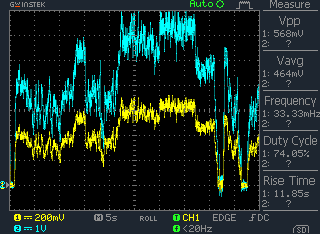Modified Buck Boost DC-DC Converter with Hyeteresis Band on Ocean Wave Emulator
##plugins.themes.academic_pro.article.main##
Abstract
Indonesia has the potential of sea wave energy with the second largest coastline having a density of up to 20 kW / m2. Currently, the use of sea wave technology is still at the prototype stage, with several weaknesses such as erratic sea waves, tides and ocean currents so that they can affect the power generated in ocean wave energy. The results of ocean wave energy in mechanical arrays cannot be utilized because of erratic waves. The higher the wave, the greater the power generated and vice versa. If this problem is not resolved, it can cause unstable power output and cause damage to electronic equipment. The solution to this problem is to modify the DC-DC buck boost converter circuit using the Hyeteresis band method, which limits voltage surges below or above to produce the desired voltage in order to maintain constant power and as energy for storage in the storage system. The result of this study is that the performance of DC generators in producing voltage is greatly influenced by speed. At low speeds, the voltage produced by the generator is still too low to charge the battery or in other words cannot be in a perfect charging position, while at maximum speed it produces voltage with Achieve a level sufficient for battery charging. Therefore, control and adjustment of generator speed is key in maximizing battery charging efficiency using a buck-boost converter.
##plugins.themes.academic_pro.article.details##

This work is licensed under a Creative Commons Attribution-NonCommercial 4.0 International License.
References
[2] D. Qiao, R. Haider, J. Yan, D. Ning, and B. Li, “Review of Wave Energy Converter and Design of Mooring System,” Sustainability, vol. 12, no. 19, 2020, doi: 10.3390/su12198251.
[3] F. Danang Wijaya and B. Azhari, “Analytical design and optimization of flat-quasi linear generator for sea wave power plant in South Java Ocean,” in 2016 8th International Conference on Information Technology and Electrical Engineering (ICITEE), 2016, pp. 1–6. doi: 10.1109/ICITEED.2016.7863276.
[4] F. M. Felayati, T. F. Nugroho, and S. Purwono, “Pemodelan Sistem Hidrolis Terhadap Variasi Tinggi Gelombang Air Laut Pada Sistem Wave Energy Hyperbaric Converter (WEHC),” Jurnal Teknik ITS, vol. 4, no. 2, pp. B140–B144, 2016.
[5] X. Hu, L. Johannesson, N. Murgovski, and B. Egardt, “Longevity-conscious dimensioning and power management of the hybrid energy storage system in a fuel cell hybrid electric bus,” Appl Energy, vol. 137, pp. 913–924, 2015, doi: https://doi.org/10.1016/j.apenergy.2014.05.013.
[6] S. Wang, L. Lu, X. Han, M. Ouyang, and X. Feng, “Virtual-battery based droop control and energy storage system size optimization of a DC microgrid for electric vehicle fast charging station,” Appl Energy, vol. 259, p. 114146, 2020, doi: https://doi.org/10.1016/j.apenergy.2019.114146.
[7] A. Hussain, V.-H. Bui, and H.-M. Kim, “Optimal Sizing of Battery Energy Storage System in a Fast EV Charging Station Considering Power Outages,” IEEE Transactions on Transportation Electrification, vol. 6, no. 2, pp. 453–463, 2020, doi: 10.1109/TTE.2020.2980744.
[8] J. A. Domínguez-Navarro, R. Dufo-López, J. M. Yusta-Loyo, J. S. Artal-Sevil, and J. L. Bernal-Agustín, “Design of an electric vehicle fast-charging station with integration of renewable energy and storage systems,” International Journal of Electrical Power & Energy Systems, vol. 105, pp. 46–58, 2019, doi: https://doi.org/10.1016/j.ijepes.2018.08.001.
[9] Y. Wu et al., “An Exploration of New Energy Storage System: High Energy Density, High Safety, and Fast Charging Lithium Ion Battery,” Adv Funct Mater, vol. 29, no. 1, p. 1805978, Jan. 2019, doi: https://doi.org/10.1002/adfm.201805978.
[10] I. Al Siyabi, S. Khanna, T. Mallick, and S. Sundaram, “An experimental and numerical study on the effect of inclination angle of phase change materials thermal energy storage system,” J Energy Storage, vol. 23, pp. 57–68, 2019, doi: https://doi.org/10.1016/j.est.2019.03.010.
[11] F. Faanzir, M. Ashari, S. Soedibyo, and U. Umar, “Determining the shortest charging time of batteries using SOC set point at constant current–constant voltage mode,” Przegl?d Elektrotechniczny, vol. 97, 2021.
[12] A. Masias, J. Marcicki, and W. A. Paxton, “Opportunities and Challenges of Lithium Ion Batteries in Automotive Applications,” ACS Energy Lett, vol. 6, no. 2, pp. 621–630, Feb. 2021, doi: 10.1021/acsenergylett.0c02584.
[13] G.-L. Zhu et al., “Fast Charging Lithium Batteries: Recent Progress and Future Prospects,” Small, vol. 15, no. 15, p. 1805389, Apr. 2019, doi: https://doi.org/10.1002/smll.201805389.
[14] M. A. H. Rafi and J. Bauman, “A Comprehensive Review of DC Fast-Charging Stations With Energy Storage: Architectures, Power Converters, and Analysis,” IEEE Transactions on Transportation Electrification, vol. 7, no. 2, pp. 345–368, 2021, doi: 10.1109/TTE.2020.3015743.
[15] M. Derbeli, C. Napole, O. Barambones, J. Sanchez, I. Calvo, and P. Fernández-Bustamante, "Maximum power point tracking techniques for the photovoltaic panel: A review and experimental applications," Energies, vol. 14, no. 22. MDPI, Nov. 01, 2021. doi: 10.3390/en14227806.
[16] H. Purnata, M. Rameli, and R. Effendie Ak, “Speed control of three phase induction motor using method hysteresis space vector pulse width modulation,” in 2017 International Seminar on Intelligent Technology and Its Application: Strengthening the Link Between University Research and Industry to Support ASEAN Energy Sector, ISITIA 2017 - Proceeding, 2017. doi: 10.1109/ISITIA.2017.8124080.

